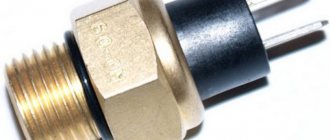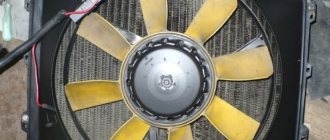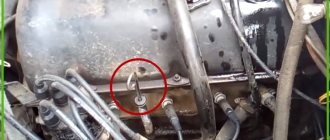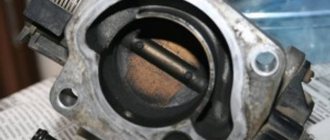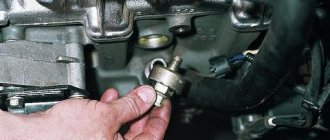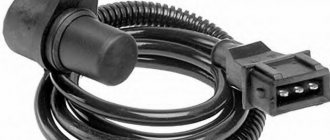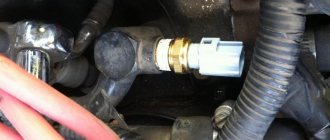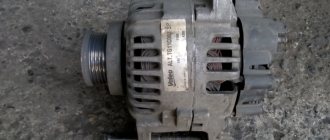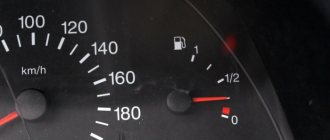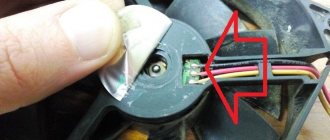Coolant temperature sensor (fan on) and its purpose
A temperature sensor or DTOZh is a part that is included in the engine cooling system and controls the process of warming it up. This element does not display the corresponding temperature values on the instrument panel, since another device is responsible for this action (temperature sensor on the DUTOZH arrow). DTOZH sends a signal to turn on the fan to cool the radiator (at a temperature of 98 to 107 degrees), through which liquid circulates. That is why such a device is often popularly called a fan sensor. However, its correct name is DTOZH or coolant temperature sensor.
In addition to turning on the fan, the DTOZH on the Priora performs another very important function. It consists of adjusting engine operation by changing the composition of the fuel-air mixture and setting the ignition timing. This is achieved by connecting the sensor to the electronic control unit. A corresponding signal about the engine temperature is sent to the ECU from the DTOZH, and depending on the incoming readings, the engine operation is adjusted. It looks something like this:
- When starting the engine cold, the ECU receives a signal that the engine has not warmed up to operating temperature (i.e., cold).
- The control unit makes a decision on preparing fuel assemblies in a certain proportion. To do this, a signal is sent to the idle speed regulator, which opens the XX valve to the appropriate distance (a certain number of steps), which leads to an increase in crankshaft speed. To quickly warm up the engine, more fuel is supplied through the injectors, and the ignition angle is also adjusted.
- When the coolant temperature rises to a certain value, the engine speed is reduced and the mixture composition is adjusted.
If on carburetor cars only liquid temperature sensors are used to display information on the dashboard, and they do not affect the operation of the engine, then on modern injection engines two types of devices are installed. If the coolant sensor is faulty, the engine will most often start and it will run, but the fuel assemblies are prepared according to average values in emergency mode (the computer, if there is no signal from the DTOZH, takes the temperature of the internal combustion engine as 0 degrees). This also turns on the fan, which cools the liquid in the radiator to eliminate the possibility of overheating the engine (since the ECU does not see the actual engine temperature).
Typical signs of a device malfunction are the following:
- unpredictable operation of the cooling fan. If a break occurs in the electrical circuit, which happens due to damage to the supply wire or sensor contacts, the fan will operate continuously
; - floating speed, since the faulty element gives incorrect signals, as a result of which the ECU will strive to adjust the optimal mixture ratio;
- The Check Engine light comes on, indicating an engine malfunction.
It is important not to confuse the coolant temperature sensor on the Priora with the element that is responsible for displaying information about the temperature of the internal combustion engine on the instrument panel. These are two different sensors that have a similar operating principle, but are responsible for performing different functions. If there is a malfunction of the device that displays the engine temperature value on the instrument panel, the CHECK indicator will not light up.
This is interesting! On the Priora, the DTOZH has two contacts, and there is only one sensor per arrow. The operating principle of the devices is the same, and the only difference between them is that on the DTOZh the resistance is measured between the terminals, and on the pointing device - between the body and the contact.
The principle of operation of the cooling system
The main task of the cooling system is to ensure optimal temperature conditions for the Priora engine. The vehicle is equipped with a system with forced circulation of coolant. Its main element is the cooling jacket through which the liquid circulates.
To maintain the integrity of the shirt, you should constantly monitor:
- quantity
- quality of the liquid (for example, Antifreeze).
If its amount is too low, the system will not be able to properly maintain the thermal regime of the power plant, and it will overheat. Antifreeze heavily diluted with water will not have adequate frost resistance, and in winter the shirt may freeze.
Another important element of the system is the liquid pump. The purpose of the pump is to ensure the circulation of Antifreeze throughout the system. The Priora pump is belt driven from the crankshaft. The condition of the pump also needs to be constantly monitored. If the bearing in it starts to fail, it will jam. The result of wedging will be:
- inability to maintain optimal temperature;
- the likelihood of a timing belt break.
Priora engine
This, in turn, will lead to damage to the gas distribution mechanism.
Until the engine reaches the desired temperature, the liquid circulates in a small circle, that is, it moves only along the jacket. When the temperature approaches normal, the liquid will begin to move in a large circle. In addition to the cooling jacket, it also includes a radiator with a fan installed on it. The cooler starts working only when the liquid temperature begins to exceed the permissible limit. For monitoring, a temperature sensor is built into the cooling jacket, also known as a fan switch on sensor.
The thermostat is responsible for which circle the Tosol moves in. Incorrect operation of the thermostat or its jamming will either lead to overheating of the unit or to the fact that it will not be able to reach the optimal thermal conditions.
This system works on a Priora like this: while the power plant is cold, the thermostat is in a position that blocks the channel going to the radiator. The liquid, thanks to the pump, circulates through the cooling jacket. As it warms up, the thermostat begins to open the channel slightly, and liquid begins to flow into the radiator to reduce the temperature of the liquid itself.
In the summer, when idling in a traffic jam, the air flow passing through the radiator is insufficient, and the temperature continues to rise. The fan switch-on sensor monitors this indicator, and if it begins to exceed the permissible limit, it turns on forced cooling of the radiator, which additionally creates an air flow to ensure cooling of the Antifreeze.
General information
On Priora and Kalina there is a fan that acts as the main cooling system. It is necessary to prevent overheating and ensure stable operation of the internal combustion engine (ICE). The main element for cooling the power unit is the sensor. Using its signal, the fan is activated.
In cars, this unit is triggered in cases where the thermal performance of the engine exceeds the norm. After starting the fan, which is located near the engine and is triggered by a signal from the controller, the temperature of the internal combustion engine drops to an acceptable level.
Important! The ventilation device does not turn on in cases where the sensor does not produce a signal. This leads to overheating of the engine.
What is the operating temperature of the Lada Priora engine?
A car engine is equipped with a cooling system that contains liquid. The temperature of this liquid is measured by a sensor. This value that it records is the engine operating temperature (ERT). The data recorded by the sensor is displayed on the dashboard. The average operating temperature of a Priora car engine is 95 degrees. This indicator is optimal when the car is moving at a speed of approximately 70-80 km/h and provided that the ambient temperature is not higher than +20 degrees. When the liquid heats up to 100 degrees, the fan turns on, which is designed for additional cooling. With such indicators, it is time to say that the power plant of the machine is functioning without failures. In winter and summer, the RTD may be different. Which RTD is considered optimal for this car? The average is 85-90 degrees.
Priora knock sensor
A knock sensor is a device that detects the knock levels of internal combustion engine processes. The installation location of such a device is the cylinder block. Maintaining it makes it possible to obtain high power, as well as achieve good fuel economy without causing damage to the engine.
The detonation process is the main defect of an internal combustion engine, since the force is considerable and it is impossible to ignore it. Among several different devices that are used as performance optimizations, the knock sensor is used to prevent knocking fuel combustions. Fuel detonation can be controlled thanks to the main indicator - the manifestation of high-pitched and ringing metallic sounds, which, according to indicators, are sometimes mistaken for the clicking sounds of the cylinder-piston group. If the process is strong enough, with faulty knock prevention systems the engine begins to fail.
Factory setting of fan temperature
The switch-on temperature depends on which ECU is installed and what options are used in it. In stock, the first fan should turn on at 97 degrees , the second at 104 degrees .
A little more and the fan should turn on. Depends on the options in the ECU.
You can change the switching characteristics using an on-board computer, for example, BC STATE. We don’t have a BC, but we connected it specifically from another machine, and set the response temperature to 95 degrees. By the way, our editorial office has one of the very first Prioras. Here the factory temperature for turning on two fans is 104 degrees .
We do not recommend the old, old-fashioned method of turning on the fan using a key.
Best temperature
After turning off the fan, the temperature should be at this level. If this is not the case, then look at the thermostat; the fastest it moves the liquid in a small circle.
The best temperature for turning on the cooling fan depends on the operating conditions of the vehicle. If the main mileage is on the highway, then the factory settings (all-suitable) will be good. If you live in a “warm town” and often get stuck in traffic jams, then it is better to lower the switching temperature. It's calmer this way.
An internal combustion engine is a complex mechanism, in order to ensure smooth operation of which a number of criteria must be met. And the temperature regime is no exception. For example, if the temperature is insufficient, this will have a bad effect on the quality of the formation of the fuel mixture in the cylinders. the cylinder-piston group may , which in turn leads to the need for long and expensive repairs.
Thus, the usual temperature (operating) for the Lada Priora engine is 85-90 degrees . When the temperature rises to 97-100 degrees , the fan should turn on automatically. If this does not work out, then the problem may lie both in the fan itself and in the sensor for turning it on . But first you should check the wire connections.
In a number of different cases, the following happens: the fan does not start due to a loose terminal. It is enough to return it to space, and the problem will be solved.
If the fan does not turn on
If the RTD has risen to 100 degrees and the indicator needle has entered the red part of the scale, this indicates overheating. Perhaps this phenomenon occurred due to the fact that the fan did not work. If you find that when it overheats, the fan does not start working and the temperature does not drop, you need to check the serviceability of the fan itself. It is necessary to determine whether the switch-on sensor is triggered when the normal RTD is exceeded? First, start the engine and disconnect the wires from the temperature sensor that is installed on the engine. When the wires are disconnected, forced cooling should work. If this does not happen, most likely the fault lies in the electric motor of the device. How to check the operation of the fan, watch the video.
If the fan turns on after disconnecting the wires, it means there is a problem with the fan switch sensor. Perhaps it incorrectly perceives data about the RTD and therefore does not operate at the right time.
This malfunction is quite easy to fix: you just need to replace the sensor. After replacing it, check if the fan turns on. To do this, start the engine. When the RTD reaches normal levels, do not turn off the engine until the temperature exceeds the norm. As soon as this happens, the fan should be activated. If the fan operates at a temperature above 97 degrees, but less than 100 degrees, then the system is functioning properly.
Throttle Position Sensor
The throttle position sensor (TPS) is installed on the throttle valve on cars without the E-GAZ system. Designed to regulate engine speed. The sensor is not reliable and often fails. If there is a malfunction, the “CheckEngine” light does not always light up.
Signs of malfunction:
- Not smooth idle;
- The revolutions are floating;
- Troubles the engine;
- When starting the engine, the speed is increased;
- Spontaneous increase or decrease in speed;
Sensor failure - main reasons
Reasons for failure of controllers and performance testing:
- Inoperative thermostat. If such a problem occurs in the car, then the fan will not work correctly. It is quite easy to verify that the thermostat is working. To do this, you need to check the lower hose, which should be hot. If the unit has cooled down, it means the thermostat has failed. It is also worth noting that for Prior and Kalin this phenomenon is quite common.
- The safety elements have failed. To check the functionality of the fuses, you will need to use a multimeter. To carry out the procedure, you should use the drawing located on the back panel of the unit. The capacity of the fuse element (“3”) must be within 50 mA. After this, it is recommended to check the fan relay, which is indicated by the number “1”.
- Contacts have been sent. In this case, you will need to find the engine compartment and check the contacts of the cooling system. In frequent cases, on Priors and Kalinas, contacts break, oxidize and break. Another problem could be winding burnout. If this is the case, the defect can be eliminated by cleaning the contacts and replacing the wiring.
- Circuit break. To solve this problem you will have to use a multimeter. If broken wires are found, they should be replaced immediately.
- The sensor itself is faulty. The controller can be diagnosed only after removing the thermostat, after which the latter must be placed in hot water.
Attention! It should be remembered that you can use a special scanner to analyze, read and reset all sensors. You can also use it to configure the on-board computer.
Characteristic signs of DTOZ failure on Priora: reasons for increased consumption
The engine temperature sensor or fan activation sensor is one of the main executive elements of the control unit. The malfunction of such a device entails incorrect operation of the engine, and the consequence of such a breakdown “hits the wallet”, because fuel consumption increases significantly. Due to the fact that the DTOZh performs a very important function, measuring the engine temperature and transmitting information to the electronic unit, such a device rarely fails. This means a complete malfunction of the sensor when the Check Engine lights up on the instrument panel and the following error codes are displayed on the on-board computer:
- P0115 - malfunction of the electrical circuit of the DTOZH;
- P0116 - sensor error in the form of values falling outside the permissible range;
- P0117 - low signal level at the DTOZh output (the ECU receives a voltage below 0.14V from the sensor);
- P0118 - increased signal level from DTOZH (output voltage over 4.91V);
- P0119 - unreliable sensor contact. Typically, this error is displayed if the signal from the device is interrupted.
There are the following types of malfunctions of TOZh sensors that are found on Priors:
- Over time, the thermistor begins to show incorrect temperature values, that is, it lies. You can verify this using a multimeter.
- Chafing of wires near the sensor connector, which also leads to its incorrect operation.
- Reduced insulation quality.
Characteristic signs that the element in question is out of order or it is “jamming” are the following manifestations:
- when cold, engine speed drops;
- lack of idling or floating speed;
- unstable operation of the internal combustion engine;
- impossibility of starting the engine when hot (due to DTOZh failure);
- turning on the fan, which is usually accompanied by error P0115.
This is interesting! However, the most common type of DTOZ malfunction on a Priora is when the cooling fans turn on and off for no apparent reason, that is, on a cold engine or if the temperature has not reached the switch-on value.
The consequence of a malfunction of the device is increased fuel consumption to 10-15 liters per 100 km. Operating a car with a faulty DTO is strictly contraindicated. If signs of its malfunction are identified, you should immediately resort to diagnosis or replacement.
Additional block
Additional relays are mounted on a bar and located under the dashboard, near the front passenger's feet. To get to them, you need to remove the right tunnel lining. Next to the additional relays is the electronic engine control unit (ECU).
If its connector interferes with access to the relay, disconnect it by first removing the negative terminal from the battery.
Circuit breakers
F1 (15 A) – main relay circuit, starter interlock.
F2 (7.5 A) – power circuit of the electronic control unit (ECU).
F3 (15 A) – electric fuel pump . If the fuel pump has stopped pumping (this can be determined by the absence of a sound when the ignition is turned on), check together with relay K2. There may also be problems with the immobilizer, it blocks the pump, see information about F20. If the wiring, this fuse and the relay are good, most likely the fuel pump itself has failed. To remove it, you need to disconnect the battery, remove the rear seat cushion, unscrew the cover, ring and fuel hoses, then carefully remove the entire fuel pump.
Relay:
K1 – main relay.
K2 – electric fuel pump relay . See above about F3.
see also
Comments 47
People, help me, my fan doesn’t turn on, I thought it was the sensor, but no, it still doesn’t turn on, but when you remove the connector from the sensor, it turns on, and if you put it back on, it doesn’t turn off, what should I do, and maybe it’s because of the cap on the expansion valve of the Priora I have?
Could be a relay or fuse
What specific wire is this?
problem solved! I changed the wire to ground and everything worked)) thank you all so much, friends!
Clean and check regularly - the effect will not last long! neither nail nor rod!
problem solved! I changed the wire to ground and everything worked)) thank you all so much, friends!
Don’t be stingy and install an on-board engine, there are a lot of benefits from it and you can set the Carlson switch-on temperature and reset errors and a lot of other things...
And the bad mass is to blame. I also crawled and changed... After changing the mass, the side panel and the tidy show a difference of a couple of degrees between themselves
Thermostat malfunction
You should also keep an eye on the thermostat. If it does not work as expected, the power unit will not be able to establish the optimal warm mode. To check the functionality of the thermostat, proceed as follows:
Action
If the pipe heats up much earlier, most likely the thermostat is stuck in the position where the Antifreeze is circulating in a large circle. The thermostat is an element that cannot be repaired; it is simply replaced.
Source
How to remove and replace the coolant temperature sensor (fan on) on a Priora
The process of replacing the sensor is not complicated, but before implementing it, it is important to know the following: before unscrewing it, you should unscrew the cap of the expansion tank and relieve the pressure in the cooling system. After this, you can begin dismantling work, but it is also important to take into account that after unscrewing the product, antifreeze will flow out of the installation hole. According to the manual, it is recommended to drain antifreeze from the radiator in an amount of at least 1 liter, but practice shows that if you relieve the pressure in the system and quickly replace the device, a small amount of liquid will leak out.
This is interesting! It is important to understand that if you are working on a warm engine, you need to either wait until it cools down or drain the antifreeze so as not to get burned in the process.
The process of replacing DTOZH on Priora is carried out as follows:
- Disconnect the negative terminal from the battery. Why do this? Naturally, no one is going to short-circuit the contacts, and the likelihood that they will close when in contact with metal parts of the engine is extremely low. However, after removing the sensor, antifreeze may get on the chip, and if there is voltage on it (there is none when the ignition is off), the ECU may short out. And therefore, if you do not disconnect the terminal from the battery, then after removing the chip, move it to the side so as to eliminate the possibility of a short circuit. However, to reduce the risk, it is better to disconnect the terminal on the battery.
- To make work easier, it is recommended to remove the air purification filter housing.
- After draining at least 1 liter of liquid from the cooling system (if you decide to go the right way), you need to disconnect the power supply. To do this, you need to pull back the tongue and remove the chip.
- Unscrew the sensor with an open-end wrench to “19”, and if liquid leaks out of the hole, quickly install a new sensor in place, having previously prepared it.
- When installing, do not forget about the copper washer.
- Tighten the sensor with a force of 9.3-15 Nm using a torque wrench.
This completes the process of replacing the fan sensor on the Priora. All that remains is to reset the errors from the BC and make sure that the engine is working properly, as well as the absence of signs that forced you to check and replace the DTOZH.
DIY fault repair
We will not talk about solving problems such as failure of fuses or the sensor itself. Everything is so simple here - failed elements are removed from their installation locations and replaced with new ones.
Separately, it is necessary to highlight the replacement of the ventilation unit - read about this below:
- So that during the repair process you do not have to dismantle the radiator, do everything carefully, since there is a possibility of damage to other elements.
- Open the hood and disconnect the battery. Remove the air filter.
- Having done this, you can dismantle the radiator grille.
- Next, you will need to unscrew the top mountings of the optics - the right and left lights.
- Using a 10mm wrench (it will be more convenient to take a socket wrench), you will need to remove the upper front panel.
- After these steps are completed, you will need to disconnect the plugs that are connected to the ventilation unit. Having done this, the wires can be twisted a little.
- Next, using a wrench, you will need to unscrew the four screws that secure the device to be replaced. The arrows in the photo indicate the screws that secure the assembly; they will need to be unscrewed.
- Only after the unit is freed will it be necessary to dismantle it and replace it with a new one. After removal, just in case, clean the connectors themselves so that in the future you will not be bothered by the problem of poor contact. Further assembly of the system and installation of all elements is carried out in the reverse order.
1. Remove the air filter.
2. Unscrew the mounting bolts marked with arrows.
Fan diagnostic method
Experts say that injection cars are considered the most practical. They can be diagnosed much faster than all others. It is advisable to use computer diagnostics to thoroughly investigate the cause of all malfunctions. Some models, when making errors, immediately show a constantly spinning fan. This helps protect against overheating.
To reset errors, you need to remove the terminal from the battery for a few seconds. After the system is cleaned, everything returns to normal.
